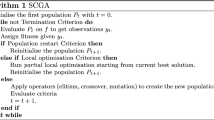Abstract
Multi-Satellite Tracking Telemetry and Command Scheduling Problem is a multi-constrained, high-conflict complex combinatorial optimization problem. How to effectively utilize existing resources has always been an important topic in the satellite field. To solve this problem, this paper abstracts and simplifies the Multi-Satellite TT&C Scheduling problem and establishes the corresponding mathematical model. The hybrid goal of maximizing the profit and task completion rate is our objective function. Since the genetic algorithm has a significant effect in solving the problem of resource allocation, we have proposed an improved genetic algorithm with population perturbation and elimination (GA-PS) based on the characteristics of the Multi-Satellite TT&C Scheduling problem. A series of simulation experiments were carried out with the total profits and the task completion rate as the index of the algorithm. The experiment shows that compared with the other three comparison algorithms, our algorithm has better performance in both profit and task completion rate.
Access this chapter
Tax calculation will be finalised at checkout
Purchases are for personal use only
Similar content being viewed by others
References
Li, J., et al.: The TT&C resource scheduling method based on multi-satellite. In: IEEE International Conference on Intelligent Computing & Intelligent Systems. IEEE (2010)
Zhang, Z., Zhang, N., Feng, Z.: Multi-satellite control resource scheduling based on ant colony optimization. Expert Syst. Appl. 41(6), 2816–2823 (2014)
Bianchessi, N., et al.: A heuristic for the multi-satellite, multi-orbit and multi-user management of Earth observation satellites. Eur. J. Oper. Res. 177(2), 750–762 (2007)
Gao, K., Wu, G., Zhu, J.: Multi-satellite observation scheduling based on a hybrid ant colony optimization. Adv. Mater. Res. 765–767, 532–536 (2013)
Yang, P., et al.: Heuristic algorithm and conflict-based backjumping algorithm for satellite TT&C resource scheduling. Yuhang Xuebao/J. Astronaut. 6, 1609–1613 (2007)
Chen, Y., Zhang, D., Zhou, M., Zou, H.: Multi-satellite observation scheduling algorithm based on hybrid genetic particle swarm optimization. In: Zeng, D. (ed.) Advances in Information Technology and Industry Applications. LNEE, vol. 136, pp. 441–448. Springer, Heidelberg (2012). https://doi.org/10.1007/978-3-642-26001-8_58
Zufferey, N., Amstutz, P., Giaccari, P.: Graph Colouring Approaches for a Satellite Range Scheduling Problem. Kluwer Academic Publishers, Dordrecht (2008)
He, R.: Apply constraint satisfaction to optimal allocation of satellite ground station resource. Comput. Eng. Appl. 40(18), 229–232 (2004)
Zhang, T., et al.: Space-ground integrated scheduling based on the hybrid ant colony optimization. Syst. Eng. Electron. (2016)
Song, Y., Ma, X., Li, X., Xing, L., Wang, P.: Learning-guided nondominated sorting genetic algorithm II for multi-objective satellite range scheduling problem. Swarm Evol. Comput. 49, 194–205 (2019)
Du, Y., Wang, T., Xin, B., Wang, L., Chen, Y., Xing, L.: A data-driven parallel scheduling approach for multiple agile Earth observation satellites. IEEE Trans. Evol. Comput. (2019). https://doi.org/10.1109/TEVC.2019.2934148
Wang, Q., Luo, H., Xiong, J., Song, Y., Zhang, Z.: Evolutionary algorithm for aerospace shell product digital production line scheduling problem. Symmetry 11, 849 (2019)
Acknowledgement
This work was supported by the National Natural Science Foundation of China under Grants 71901213, 61473301 and 71690233.
Author information
Authors and Affiliations
Corresponding authors
Editor information
Editors and Affiliations
Rights and permissions
Copyright information
© 2020 Springer Nature Singapore Pte Ltd.
About this paper
Cite this paper
Chen, M., Wen, J., Pi, BJ., Wang, H., Song, YJ., Xing, LN. (2020). A Novel Genetic Algorithm with Population Perturbation and Elimination for Multi-satellite TT&C Scheduling Problem. In: Pan, L., Liang, J., Qu, B. (eds) Bio-inspired Computing: Theories and Applications. BIC-TA 2019. Communications in Computer and Information Science, vol 1159. Springer, Singapore. https://doi.org/10.1007/978-981-15-3425-6_44
Download citation
DOI: https://doi.org/10.1007/978-981-15-3425-6_44
Published:
Publisher Name: Springer, Singapore
Print ISBN: 978-981-15-3424-9
Online ISBN: 978-981-15-3425-6
eBook Packages: Computer ScienceComputer Science (R0)




